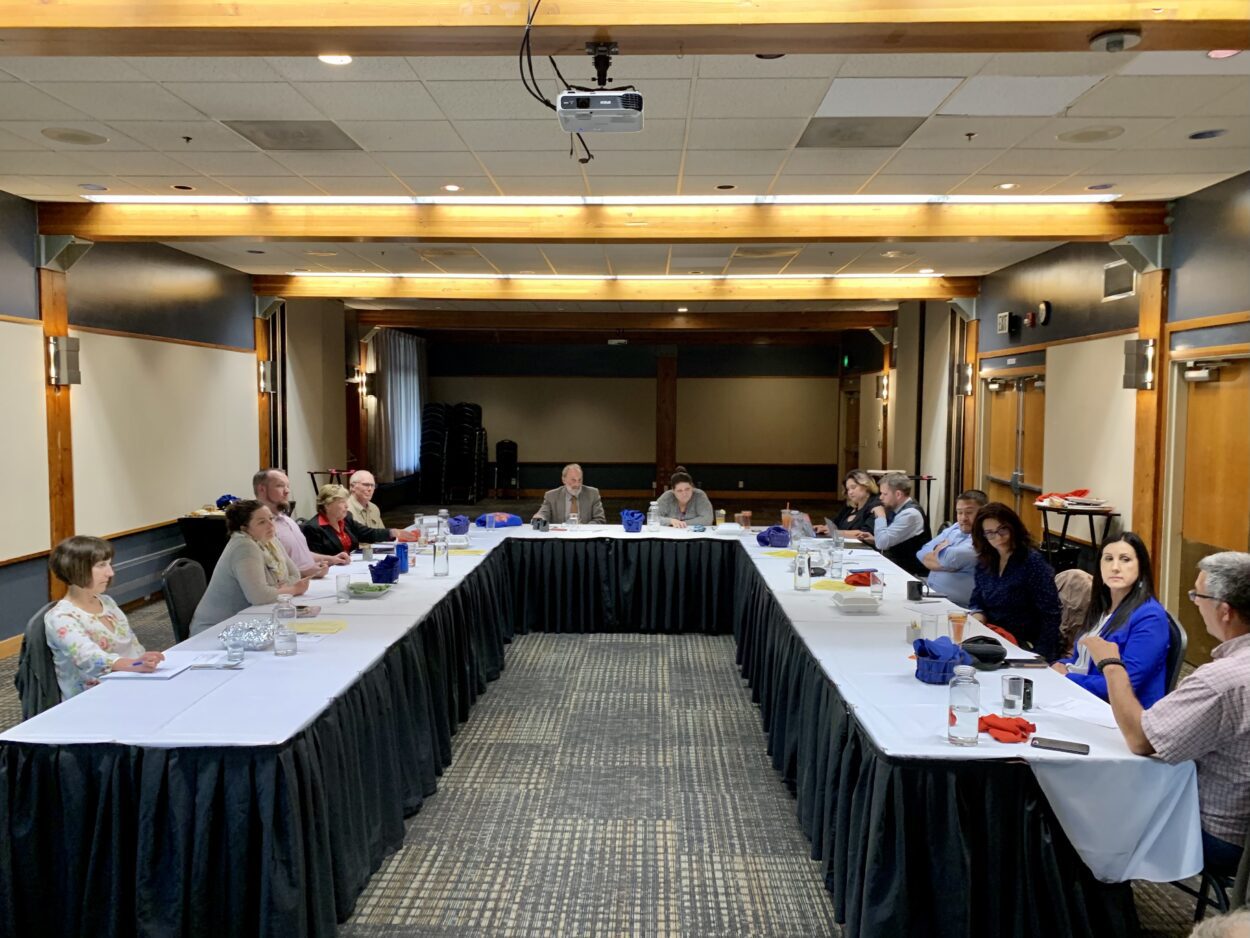
Members of the Ketchikan Gateway Borough School District Board of Education meet with members of Ketchikan Indian Community’s Tribal Council during a government-to-government consultation at the Cape Fox Lodge on Wednesday. From left: School Board Clerk Kerry Watson, School Board Members Bridget Mattson, Paul Robbins Jr., Diane Gubatayao and Doug Gregg, School Board President Kim Hodne, Tribal Council President Gloria Burns, Tribal Council Executive Assistants Crystal Mann and Aaron Burns, Tribal Council Members Lloyd Ruaro, Trixie Bennett, Melissa Johnson and Chas Edwardson. (Eric Stone/KRBD)
Ketchikan’s school board and representatives from the local tribal government met Wednesday to share a meal and discuss improving education for the community’s students.
Among the top priorities for Ketchikan Indian Community’s Tribal Council was addressing disproportionate educational outcomes for Alaska Native students.
Alaska Native students’ graduation rates and test scores have lagged significantly behind the district average on a consistent basis. As of the 2018-2019 school year — the most recent year for which data is available — 63% of Native students graduate within four years. That’s 18 percentage points less than the district-wide average of 81%. Test scores show a similar gap in Alaska Native student achievement in Ketchikan.
Tribal Council President Gloria Burns acknowledged that not every student will graduate high school. She said some will find success in a trade, for example — but “there has to be a plan to make sure that there’s a 100% success rate, because there’s not a 100% success rate yet. But there will be.” Burns said. “That’s the mindset that we’re that we’re looking to be in.”
One potential solution the Tribal Council shared was to better integrate Tlingit, Haida and Tsimshian culture into daily curriculum that goes beyond performance art and crafts.
“When we’re talking about culture, we aren’t talking about song and dance — although song and dance is great, and all the kids love it — and we’re not necessarily talking about the food and medicine — which is great, and it’s integral to our spiritual and social [and] all of our needs,” Burns said. “But there are traditional values that we have as Indigenous people.”
She referenced the Central Council of Tlingit and Haida Indian Tribes of Alaska’s Southeast Traditional Tribal Values, which Ketchikan Indian Community has adopted — values like patience, environmental stewardship and holding each other up.
“And one of them is humor, and what that looks like,” she said. “We just want to see those embodied in our district.”
She pointed to the Tongass School of Arts and Sciences, a public charter elementary school within the district, as an example for other schools to follow.
School Board Member Diane Gubatayao said she, too, wanted to see cultural education woven seamlessly into classwork — she suggested integrating some Sealaska Heritage Institute materials into the elementary school reading curriculum and discussing the oftentimes tragic history of colonization.
“As the parent of Native children, I don’t want just tag-on classes, I guess is how I’d put it,” she said. “I really hope that we integrate the culture into our curriculum in a meaningful way that will be for perpetuity.”
School Board Member Paul Robbins Jr. said success for all students was a laudable goal, and agreed that there’s work to be done. But he said there’s only so much the district can do.
“There’s so much about the dropout rates, that has to do with the family situation at home, and socioeconomic situation for parents that we just can’t affect,” Robbins said.
Some Tribal Council members voiced their agreement, saying some families struggle with things like drug addiction or homelessness. Burns suggested one part of the solution could be for tribal members to volunteer to serve as adult mentors — or “aunties,” as she put it — for struggling Native students.
Much of the meeting focused on funding: how the district could better consult with the tribe on how federal education funds are spent on things like teachers’ aides, early childhood education and school lunches.
“We have to figure out what the most meaningful way for us to have the input back and forth to create measurable outcomes for all of our kids looks like,” Burns said.
She asked the board to consider taking free training from the National Indian Education Association to better understand the rules for tribal consultation instituted under the Obama-era Every Student Succeeds Act.
Though public notice requirements prohibited the school board from taking immediate action on the tribe’s suggestions, President Kim Hodne said the tribe’s input had not fallen on deaf ears.
“From here, we will be better in the next quarter. And we will be better after that, in direction and training,” Hodne said.
Interim Ketchikan superintendent Melissa Johnson attended the meeting, but as an elected member of the Tribal Council. She said the district was piloting a new evaluation program to ensure teachers follow Alaska’s state cultural standards.
Burns said that while the discussion centered on how to help Native students succeed, integrating Southeast tribal values into education would help all students better understand their home.
“I just like to repeat with Liz Medicine Crow always says: What’s good for a Native child is good for every child,” Burns said.
Tribal officials say they plan to issue a letter with their suggestions for the school district later this month.








